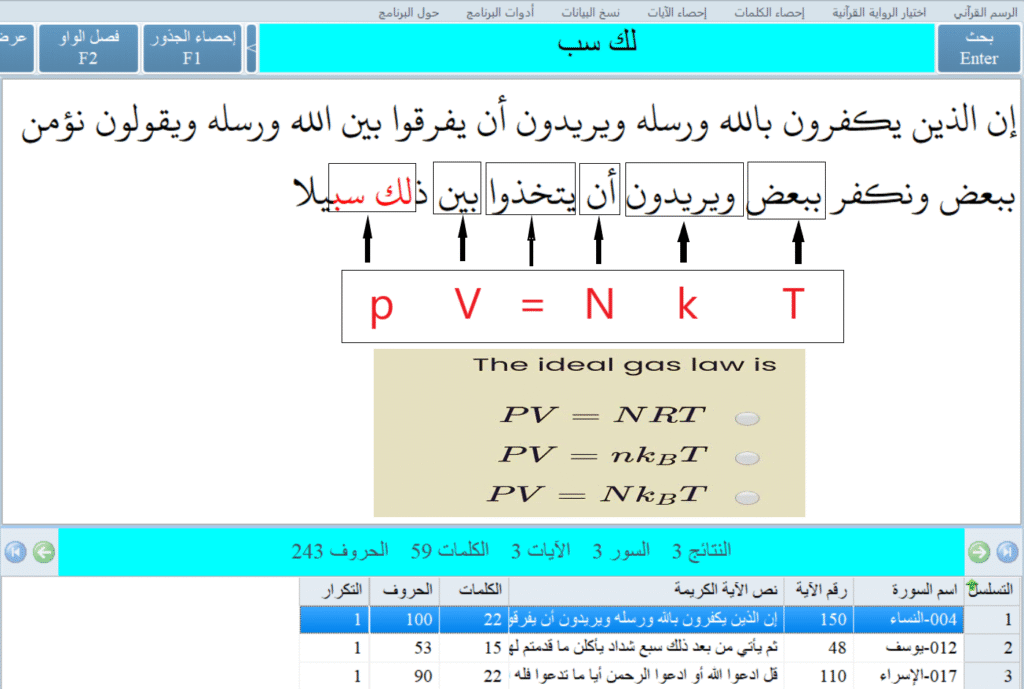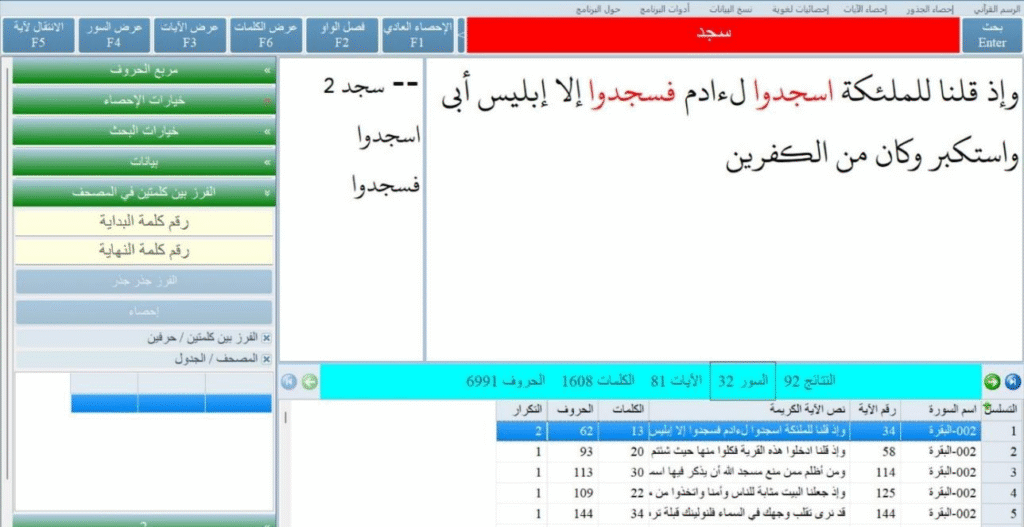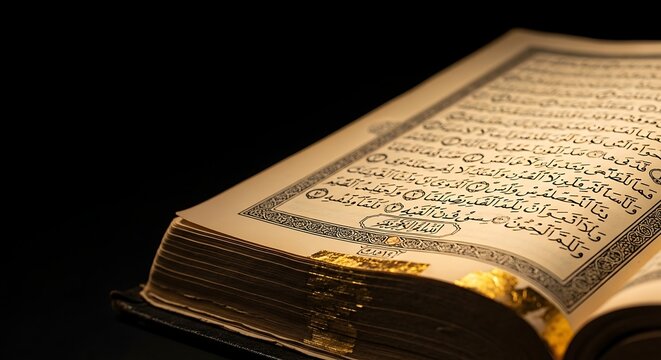Beyond elements, molecules are encoded in the Quran. Beyond molecules, subatomic particles are encoded. In addition to subatomic particles, many scientists, the revolutions they brought about, and the dates of these discoveries are encoded. Furthermore, universal, cosmological, physical, and chemical constants – their names and values – are encoded. The encodings in the Quran are so perfect that no one can ever equate any other book with the Quran based on just a few data points. We will present hundreds of miracle criteria to such individuals and ask them to derive all these miracles simultaneously from the same book. Only then will the perfection and DIVINE nature of the cryptography and coding in the Quran become clearly understood.
Let them scan texts written in Arabic if they wish, or texts in Hebrew and Aramaic, or any other language they choose. No matter which language they choose, the result will not change. They will easily recognize the super-superiority present in the Quran. Nevertheless, we recommend that such individuals proceed with Arabic, Hebrew, and Aramaic, because in Latin languages, once the letter sequences reach 6-7 letters, the searched letter sequence often does not occur in the text at all. We conducted many experiments with Latin texts and found that Latin languages cannot compete with Arabic in this regard. Therefore, to make it easier for those who wish to respond to the Quran’s challenge, we recommend they proceed with Arabic, Hebrew, and Aramaic. It is highly remarkable that these three languages were chosen for Holy Scriptures and that all three possess the advantage of diacritical marks.


Additionally, an extra point needs to be clarified here. In modern Arabic, when writing technical modern terms, transliteration is performed by matching all letters with an Arabic character without assuming any diacritical (hareke) advantages. This may be common in modern books, but it is not a cryptologically optimized method. In the Quran, however, names are often encoded using fewer characters by leveraging diacritical advantages. Therefore, one should not question why the letter sequences we find are not identical to their modern Arabic written forms, as doing so would only prove their lack of familiarity with the Quran.
For example, the word “kitab” (book) is written in the Quran in some places with the letter alif as كتاب, while in other places it is written without alif, using diacritics instead, as كتب. There are hundreds of similar examples throughout the Quran. Those interested in learning more about this can research the science of Rasm al-Masahif (رسم المصاحف). The conclusion to be drawn is:
A word can be encoded with fewer characters when necessary by leveraging diacritical advantages. Therefore, the presented letter sequences do not have to be as long as their modern Arabic forms, nor do they have to be identical to them.
Another methodological detail to be explained here is:
The discovered letter sequence must be consecutive. This consecutiveness does not necessarily have to be within the same word. For instance, some letters of a sequence may be in one word, while others may be in the following word. The sequence does not have to be confined to a single word, and in some cases, this is impossible because Arabic may not even have words of such length. The general rule is that the letter sequence must be consecutive. This consecutiveness can span across two consecutive words or even two consecutive verses. For example, part of the sequence may be at the end of one verse, while the rest may be at the beginning of the next verse. A beautiful example of this in the Quran can be found through the disjointed letters (muqatta’at).

Surah Ash-Shura begins with disjointed letters (muqatta’at). As is known, muqatta’at consist of consecutive letter sequences. In the case at the beginning of Surah Ash-Shura, the muqatta’at letters appear consecutively but not within the same word. Rather, they appear as two consecutive words. In fact, this consecutiveness even spans two consecutive verses. After understanding this example, no one should ask, “Why are the letter sequences you found not in the same word or the same verse?” because this method is directly derived from the Quran itself.
Finally, suppose a letter sequence is repeated in multiple locations. It is not necessary for the same numerical value referenced by that sequence to be encoded in every occurrence – indeed, it may not even be possible. In the Quran, some letter sequences are encoded only once, and at those locations, they point precisely to the expected numerical value. However, some letter sequences are encoded in multiple locations, and the same value is not encoded in all of them. There is no need to expect otherwise, as the purpose of encoding these sequences is not necessarily limited to the data we hypothesize.
For example, we may observe that a letter sequence points to a specific numerical value in one location but not in others. In such cases, the following possibilities may be considered:
- Other data related to what the sequence represents may be encoded in those locations.
- The occurrence of the sequence in those locations may be a natural result of words conveying a specific meaning.
For instance:
- In one location, the sequence “Copernic” may point to the atomic number of the element Copernicium, while in another, it may point to the start date of the Copernicus space program.
- Similarly, the sequence “Pascal” may encode atmospheric pressure in one location and the Boltzmann constant (based on the ideal gas law) in another.
If some ask how we can prove that the locations we claim to be miraculous are indeed so, we respond:
In some cases, probability calculations have been performed specifically to answer this question. No rational person can accept that such low-probability data could occur by chance. The probabilities obtained in these calculations are even lower than the 5-sigma value used in science, and the entire scientific community acknowledges that such low-probability events can only occur through intentional design and knowledge. Moreover, the Quran does this not just once but dozens of times, pointing to highly precise data using similar methods. When all these signs are considered together, claiming that they are merely coincidences is unacceptable to any rational thinker.
It is impossible to obtain the data presented in this book, with the same precision and rarity, from any other source besides the Quran. In fact, probability calculations have been conducted in some cases to prove this. To those who wish to challenge the data presented in this book, we issue a challenge and outline our conditions:
- Temporal Priority: The Quran referenced these data centuries before their discovery. If you challenge the data in this book, you must present similar data from books written before the discovery of these facts – only then can the condition of miracle be satisfied. Otherwise, searching for signs in a chemistry book now, after all the data has been discovered and named, demonstrates a complete misunderstanding of the data presented here. When the Quran was revealed, no one knew about these facts.
- Internal Evidence: The Quran contains disjointed letters (muqatta’at), hinting at the presence of encodings. Therefore, those who wish to challenge the data must provide internal evidence from their chosen text indicating that it contains encodings. Otherwise, their data could be dismissed as coincidental. The Quran itself references the existence of numerical evidence, particularly through the concept of muqatta’at. Thus, challengers must prove that their text contains encodings using methods such as muqatta’at. Failure to do so shows a lack of understanding.
- Linguistic and Cryptographic Complexity: The Quran encodes words from other languages using Arabic. Transliterating words across languages is challenging due to linguistic asymmetries. Therefore, anyone attempting to find similar patterns in an English text – for example, searching for the element “Berkelium” based on the name “Berkeley” – has fundamentally misunderstood the data. The Quran is an Arabic text where sequences pointing to foreign proper names are encoded consecutively across multiple words. Challengers must adhere to similar constraints and avoid directly searching for element names in their texts.
- Comprehensive Scope: The Quran references over 110 elements by their names and chemical properties. Challengers must demonstrate that their text references at least 110 elements in a similar manner to even begin competing with the Quran. Those who pass this stage will be challenged to find references to molecules, subatomic particles, scientists’ names, and associated numerical values. Those who succeed in that will be challenged to find cosmological constants from their text, matching the number of cosmic constants referenced in the Quran. We are confident that challengers will stumble at the first stage, but we have outlined only the tip of the iceberg to put them in their place. We haven’t even mentioned the hidden depths beyond.
There are other conditions as well, but the general idea is clear:
If you wish to challenge the Quran, first strive to understand the phenomena occurring within it, and then conduct your research under similar conditions. If you fail to do this, any data you present will be worthless.
B. Meaning-Related Formulation Method
In the QURAN, a connection can be established between the subject of certain verses and the scientific formulas related to that subject. For example, the Earth’s equatorial linear velocity can be formulated as follows:


As seen above, the Earth’s equatorial linear velocity is calculated as the ratio of the equatorial circumference to the Earth’s rotation period. In alignment with this formula, the Quran points to the Earth’s rotational speed at the equator through the ratio of the arrangement of a verse referring to the Earth’s rotation to the total number of verses in the Quran. The similarity between the two cases is as follows:
Earth’s Equatorial Linear Velocity = V = Equatorial Circumference / Rotation Period
In the Quran, V = Arrangement of the verse related to the Earth’s rotation / Total number of verses in the Quran
As can be seen, a derivation can be made by establishing a similarity between a scientific formula and a relevant verse from the Quran.
If another example is to be given:
The universal gravitational constant formula is as follows:


In this formula, the symbol G represents the universal gravitational constant. Notice that to calculate this constant, the product of certain numbers is divided by the product of certain other numbers, yielding the constant G.
Although not an exact one-to-one correspondence, in a manner similar to this, the universal gravitational constant can be derived from a relevant position in the Quran using the following formula:

The three crucial data points related to the analyzed verse are as follows:
- Number of letters in the verse: 15
- Total number of words in the Quran from the beginning up to the word ‘Hubuk’ (الْحُبُكِ) in the analyzed verse: 67,183
- Total number of letters in the Quran from the beginning up to the word ‘Hubuk’ (الْحُبُكِ) in the analyzed verse: 282,486
- The most well-known constant in the Quran: 19
Notice that, similar to the universal gravitational constant, the value of the gravitational constant can be derived with exceptional precision through a analogous formulation. Although the formula does not always match exactly, it can follow a similar structure. Nevertheless, the accuracy of the presented data serves as clear evidence that it is not coincidental.
If another example is to be given:
The ideal gas law is as follows:

In this equation, by converting between the gas constant and the Boltzmann constant, the following equation can also be obtained:

In this equation, the symbol P represents the unit of pressure and is measured in Pascals. It has been observed that in the Quran, some equations are encrypted as an embedded system. For example, at a position where the letter sequence “Pascal” is derived, the symbol P in the equation aligns with the sequence “Pascal”, and by assigning a word to each symbol in the equation, the Boltzmann constant can be obtained. If this is visualized, the following situation appears:

It is remarkably observed that the word aligned with the symbol k, representing the Boltzmann constant, contains an encoded value of the Boltzmann constant itself. The Quran includes many fascinating data encodings of this nature. In this latest example, both the letter sequence arrangement method and the data formulation method are intricately intertwined.
In the Meaning-Related Formulation Method, similar types of encryption are observed. By providing these examples, our aim is to offer a general understanding of this methodology. Due to the selection of the most robust data points, only a limited number of examples have been presented in the book. However, our goal is to introduce a methodology and provide long-term guidance for Quran researchers to professionally derive new data from the Quran.
Furthermore, the methodology presented in the “Derivation via Letter Sequence Method” can also be applied within the “Meaning-Related Formulation Method”. The approaches introduced in the “Derivation via Letter Sequence Method” can be utilized in the data presented through other methods as well.
C. Data Encryption Method Using Prime Numbers and Factors
Since the data presented in this book is related to the fields of cryptology and cryptography, and since prime numbers hold indispensable importance in these fields, and considering that the Quran is conveyed in a manner comprehensible to people, it becomes abundantly clear how logical it is to perform data derivation from the Quran using prime numbers and factorization methods. In this section, some information will be provided regarding the importance of prime numbers in cryptology.





Since prime numbers hold immense importance in modern cryptology, and since the Quran is a BOOK revealed to humanity, it is both logical and expected that data within the Quran would be encrypted using methods that are widely known, understood, and frequently used in cryptology. Observations indeed confirm this. Another significant reason for presenting this method is to introduce a concept that may assist Quran researchers in the long term.
D. Data Encryption Method Using Letter and Word Frequency
In the Quran, certain data are repeated multiple times, enabling numerical encryptions based on these repetitions. For example, the repetition count (frequency) of a specific word throughout the Quran or within a specific context can encrypt numerical data related to that word. Considering that the Quran was revealed over 23 years in fragments, believing that such data could have been orchestrated simultaneously by a human is akin to closing one’s eyes to the Light of the Quran. Indeed, all historical sources confirm that the Prophet (peace be upon him) could neither read nor write. Such data cannot be the product of an illiterate individual. Moreover, when considering the style of the Quran’s revelation, it is impossible that these details were planned by people of that era.
The encryption of data through frequency in the Quran is highly logical, as such data falls into the category of information that is easiest to detect. The frequent repetition of certain letters and words captures the reader’s attention and encourages immediate investigation and counting. To illustrate this, consider the following analogy:
Imagine a person prospecting for minerals. As they approach deposits, signals from their detector increase, providing clues about where to find minerals. Similarly, when data miners observe certain word groups, letters, or verses repeating frequently in QURAN, these high-frequency signals serve as clues for data derivation.
Here, some hints will be provided regarding data encryption through letter and word frequency in the Quran, and examples will be presented throughout the book series. For instance, the word “Leyl” (ليل), meaning “night,” appears in all its forms 92 times in the Quran. In harmony with this, Surah Al-Layl (The Night) is precisely the 92nd chapter of the Quran. The numerical alignment between the frequency of the word “Leyl” (92) and the ordinal position of Surah Al-Layl (92) serves as a signal hinting at the encryption of numerical data within the Quran.

The verses containing the word “Leyl” (ليل) and their respective occurrence counts will be shared on our website, www.mearic.blog, for detailed research. Similarly, the root word “Secde” (سجد) appears in 32 different surahs throughout the Quran, and in harmony with this, Surah As-Sajda is the 32 nd surah. Here, too, a numerical relationship is observed between the frequency of the root word “Secde” in the Quran and the ordinal position of Surah As-Sajda.

Such data can be regarded as signaling the presence of numerical encryption within the Quran. The synchronous occurrence of these patterns clearly demonstrates that this phenomenon is not coincidental. It cannot be attributed to the compilation by the Prophet’s companions either, as this book series presents highly technical data that could not have been known to them 14 centuries ago. The evidence provided in this book unequivocally proves that the arrangement of the Quran is DIVINE and that the Quran has been preserved letter for letter. For instance, analyses such as the “parsec” study, the universal gravitational constant analysis, the cesium element analysis, and others clearly demonstrate that the Quran has been preserved down to the letter and that its arrangement is DIVINE. The “Peter Higgs” analysis, for example, vividly illustrates that the Quran has been preserved at the verse level and that its order is DIVINE. These examples can be multiplied further.
Examples related to word and letter frequencies continue:
In the Quran, the word “prophets” appears in three plural forms: “nebiyyuun,” “nebiyyiin,” and “enbiya,” with a total of 21 occurrences. In harmony with this, Surah Al-Anbiya (The Prophets) is precisely the 21 st surah.
- “Nebiyyuun” (نبيون) appears 3 times (2:136, 3:84, 5:44),
- “Nebiyyiin” (نبين) appears 13 times (2:61, 2:177, 2:213, 3:21, 3:80, 3:81, 4:69, 4:163, 17:55, 19:58, 33:7, 33:40, 39:69),
- “Enbiya” (انبياء) appears 5 times (2:91, 3:112, 3:181, 4:155, 5:20).
Signal data based on word and letter frequencies continue:
For example, the word “Imran” appears exactly 3 times in the Quran, and in alignment with this, Surah Al-Imran is the 3 rd surah. These occurrences are found at 3:33, 3:35, and 66:12.
In the Quran, the similarity between the creation of Prophet Adam (a.s.) and Prophet Jesus (a.s.) is explained as follows:
3:59
Indeed, the example of Jesus in the sight of Allah is like that of Adam. He created him from dust, then said to him, “Be,” and he was.
Here, attention is drawn to the similarity between the two creations: Adam (a.s.) was created without a father or mother, while Jesus (a.s.) was created without a father. This serves as a refutation of the Christians’ erroneous belief that “Jesus is the son of God.”
Just as the similarity in their creation is emphasized thematically, this parallelism is also highlighted numerically in the Quran through the frequency (repetition) of the names “Adam” and “Jesus.” Specifically, both names appear exactly 25 times each throughout the Quran. The occurrences are summarized in the following table:
| Occurrence Order | Isa (peace be upon him) Name | Verse Number | Verse Number | Adam (peace be upon him) Name |
|---|---|---|---|---|
| Surah Name and Number | Surah Name and Number | |||
| 1 | 002-Al-Baqarah | 87 | 31 | 002-Al-Baqarah |
| 2 | 002-Al-Baqarah | 136 | 33 | 002-Al-Baqarah |
| 3 | 002-Al-Baqarah | 253 | 34 | 002-Al-Baqarah |
| 4 | 003-Ali ‘Imran | 45 | 35 | 002-Al-Baqarah |
| 5 | 003-Ali ‘Imran | 52 | 37 | 002-Al-Baqarah |
| 6 | 003-Ali ‘Imran | 55 | 33 | 003-Ali ‘Imran |
| 7 | 003-Ali ‘Imran | 59 | 59 | 003-Ali ‘Imran |
| 8 | 003-Ali ‘Imran | 84 | 27 | 005-Al-Ma’idah |
| 9 | 004-An-Nisa | 157 | 11 | 007-Al-A’raf |
| 10 | 004-An-Nisa | 163 | 19 | 007-Al-A’raf |
| 11 | 004-An-Nisa | 171 | 26 | 007-Al-A’raf |
| 12 | 005-Al-Ma’idah | 46 | 27 | 007-Al-A’raf |
| 13 | 005-Al-Ma’idah | 78 | 31 | 007-Al-A’raf |
| 14 | 005-Al-Ma’idah | 110 | 35 | 007-Al-A’raf |
| 15 | 005-Al-Ma’idah | 112 | 172 | 007-Al-A’raf |
| 16 | 005-Al-Ma’idah | 114 | 61 | 017-Al-Isra |
| 17 | 005-Al-Ma’idah | 116 | 70 | 017-Al-Isra |
| 18 | 006-Al-An’am | 85 | 50 | 018-Al-Kahf |
| 19 | 019-Maryam | 34 | 58 | 019-Maryam |
| 20 | 033-Al-Ahzab | 7 | 115 | 020-Taha |
| 21 | 042-Ash-Shura | 13 | 116 | 020-Taha |
| 22 | 043-Az-Zukhruf | 63 | 117 | 020-Taha |
| 23 | 057-Al-Hadid | 27 | 120 | 020-Taha |
| 24 | 061-As-Saff | 6 | 121 | 020-Taha |
| 25 | 061-As-Saff | 14 | 60 | 036-Ya-Sin |
In the Quran, when referring to Prophet Jesus (peace be upon him), he is sometimes mentioned as “Al-Masih” (the Messiah). If the word “Isa” (Jesus) had been used in those instances instead of “Al-Masih,” the table provided above would not be observable. Thus, it is evident that every word in the Quran is chosen with specific wisdom. Indeed, in the verse discussing the similarity in creation between Adam (a.s.) and Jesus (a.s.), the word “Isa” is used, and it is the word “Isa” that appears an equal number of times as the word “Adam.”
In addition to the above, when Prophet Jesus (a.s.) is mentioned in the Quran, he is referred to as “Son of Mary” (Ibn Maryam – ابن مريم) exactly 23 times. This is particularly intriguing because humans typically have 23 chromosomes from the mother and 23 chromosomes from the father, totaling 46 chromosomes. Since Prophet Jesus (a.s.) was created without a father, the phrase “Son of Mary” appears 23 times, alluding to the 23 chromosomes inherited solely from his mother. Here, we are not claiming that Prophet Jesus (a.s.) had only 23 chromosomes; rather, we emphasize the symbolic significance of the 23 chromosomes from his mother. The locations of these occurrences are provided on our website.

The general concept of data encryption through the frequency method is as illustrated in the examples above. In this book series, some compelling data related to this method will be presented. While numerous data points have been derived from the Quran using this method, only those we consider most robust will be included. The minimum idea we hope to convey to the reader is: “There are numerical encryptions in the Quran, and such data serve as signals for these encryptions.”
For instance, the 6th chapter of the Quran is Surah Al-An’am (The Cattle), and the word “An’am” (cattle) appears exactly 6 times within this surah. These occurrences are found in verses 6:136, 6:138 (three times), 6:139, and 6:142. While this data alone may not qualify as a miracle, it could be one of the signals indicating that data is encoded in the Quran through frequency patterns.
Additionally, some extra signal data will be presented here through frequency analysis. It is hoped that these will capture the attention of some readers.
For example:
- The story of Prophet Jonah (a.s.) is detailed in Surah As-Saffat, spanning 10 verses, and in harmony with this, Surah Yunus (Jonah) is the 10 th chapter of the Quran.
- The story of Prophet Hud (a.s.) in Surah Hud is narrated across 11 verses, and Surah Hud is the 11 th chapter.
- The story of the People of the Cave (Ashab al-Kahf) in Surah Al-Kahf is told in 18 verses, and Surah Al-Kahf is the 18 th chapter.
- The story of Maryam (Mary) in Surah Maryam is recounted in 19 verses, and Surah Maryam is the 19 th chapter.
- In Surah Al-Ankabut (The Spider), from the verse mentioning “Ankabut” (spider) to the end of the surah, there are 29 verses (or alternatively, the “Ankabut” verse is the 29 th verse from the end). In alignment with this, Surah Al-Ankabut is the 29 th chapter of the Quran.
Prayer (Salah) was made obligatory during the Night of Isra (Isra and Mi’raj), and the total number of obligatory rak’ahs in a day is 2 + 4 + 4 + 3 + 4 = 17. Correspondingly, Surah Al-Isra is the 17 th chapter of the Quran.
E. Data Encryption Method with Symmetries
With this method, symmetries occurring in the QURAN can be derived both in terms of meaning and through Surah and Verse numbers. For example, in the QURAN, the word roots for ‘angel’ and ‘satan’ each appear 88 times, an equal number. This situation is a type of symmetry; because the concepts of ‘angel’ and ‘satan’ are two opposite concepts, and both of these concepts appearing an equal number of times presents a beautiful symmetrical picture. Similarly, the two opposite concepts of ‘world’ and ‘hereafter’ also each appear 115 times, an equal number, forming a beautiful symmetrical picture. Such data can be considered as signal data regarding the preserved nature of the QURAN. In addition to these, some very special symmetrical situations have occurred in the QURAN through Surah and Verse numbers. This data should be considered as data proving that the arrangement of the QURAN is DIVINE and also showing that the QURAN is preserved; because the probability of these symmetries occurring simultaneously is lower than one in quadrillions. It is impossible for these symmetries to have been made by humans 14 centuries ago without a DIVINE arrangement. Methodologically on this subject, certain symmetries are selected from the presented data, either in terms of meaning or numerically. The selection of symmetry as a miraculous criterion stems from symmetry being a DIVINE seal manifesting in the universe. Therefore, the existence of numerical equivalents of the symmetry seal manifesting in the universe within the QURAN shows that the ONE who CREATED the book of the universe and the ONE who SENT the QURAN is the same ONE.
Finally, before concluding the methodology section, some explanations regarding units will be provided.
Methodology on Units
The result our observations have led us to, based on the analysis of the QURAN, is as follows:
In the QURAN, the masses of quantum particles are generally indicated using the unit MeV/c² or its submultiples and multiples. Similarly, the masses of atoms and molecules are indicated using the gram/mol unit or its submultiples. It can also be said that the masses of atoms are indicated using the atomic mass unit. It is observed that universal constants are indicated using the universal units most commonly used by science. However, methodologically, an indication made using a unit universally accepted by science falls into the miracle category. Regarding dates, it is observed that indications occur based on both the Hijri calendar and the Gregorian calendar, and this situation is also indicated in the QURAN. Indeed, in Surah Yunus, it is stated:
10:5
هو الذي جعل الشمس ضياء والقمر نورا وقدره منازل لتعلموا عدد السنين
والحساب ما خلق الله ذلك إلا بالحق يفصل الءايت لقوم يعلمون
He is the One who made the Sun a source of light; the Moon a reflected light and has appointed for it phases so that you may know the number of years and the calculation. Allah created this only with truth. He details the signs for a people who know.
This verse, while speaking of calculation and the count of years, takes two things as reference: the Sun and the Moon. Therefore, it is logical and rational for the QURAN to contain indications based on both the Solar-based and universal Gregorian calendar, and the Lunar-based Hijri calendar, which is used by one-fifth of the world’s population and is thus also universal. The factor of universality shows its effect in units, as it does in other matters. Since the QURAN is a universal BOOK, it is quite natural for it to contain indications using universal units. Furthermore, in Islam, the times for the daily prayers are determined based on Sun, while the observance of the Ramadan fast is regulated based on Moon. Consequently, it is highly logical for the QURAN to make references to both the Hijri and the Gregorian calendars.










Leave a Reply